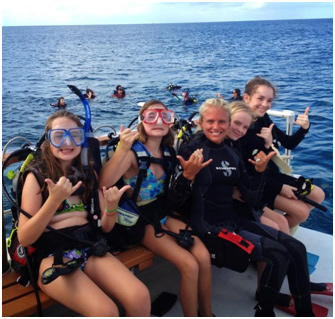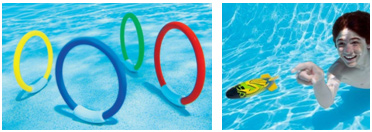5 Tips for Teaching Kids to Scuba Dive

The more you understand how a kid experiences learning, the more effective teacher you will be. Naturally, kids are very different from adults in the means of physical abilities, motivational stimuli, and perceptions of success; these are some of the factors that contribute to the way kids learn to dive. When you are teaching a kid to scuba dive, it requires some serious energy to place yourself in their shoes (or fins!).
Children learn most effectively by their own motivation, but to aid in this process of gaining a connection to stimulate learning, here are a few simple tips and tricks to help you succeed.
Introduce them to scuba slowly – First impressions form quickly and are often hard to change. Introduce kids to scuba slowly, allowing them to gain the motivation to learn how to scuba on their own terms. This can be achieved by taking a kid snorkeling around a group of scuba divers, showing a fun scuba diving or marine life related video, or my favorite – allow kids to swim and play in the pool while someone they feel comfortable with is on scuba. Naturally in a controlled environment without marine life, their focus will be on the diver. Playing games with underwater torpedoes and blowing bubble rings might be all it takes to motivate a kid to learn how to scuba dive.
The gear needs to fit! – When a child is ready to take the plunge, be sure to have dive equipment that fits them. This is extremely important to their overall comfort and ability to maneuver in the water. Remember, first impressions can leave lasting impressions – you want kid divers to comfortably swim in the water, not in their equipment. This includes a properly fitted BCD, fins that will not create blisters, a small mask with a soft skirt, rash guard or wetsuit to keep them warm, a small cylinder for weight/size reduction (AL40, 50, 63 tends to work well depending on air consumption rate) and a small mouth piece for their regulator. These details are important and count towards their in-water comfort.
Incorporate games – Make scuba diving FUN! If you ask a kid to complete skills repeatedly, one right after the other, it’s likely they will get bored and unmotivated to continue diving. Incorporate games with (hidden) learning objectives in place. After teaching them the basics (mask clearing, regulator recovery and clearing, the fundamentals of neutral buoyancy and inflation at the surface) incorporate some games in a pool session. A few of our favorites include passing an underwater toy torpedo back and forth. This allows kids to focus on a fun activity and practice neutral buoyancy at the same time. Naturally they may laugh or giggle during the game, requiring them to clear their mask. Make sure they have mastered these skills prior to performing in-water games. Another fun activity to incorporate in a pool session is attaching images of underwater fish or critters they may encounter while diving in the open water to lightweight objects or rings that sit on the bottom. Once they grab the ring, come to the surface to discuss the critter including their behaviors, what they eat, how they move in the water, and more.
Learn how to ask questions – If you want to know what a kid is thinking, steer clear of generic questions. For example, “how was your scuba class today?” will most likely result in an answer along the lines of, “Fine, good, fun, okay…” You get the idea. Ask kids engaging questions to talk about their dive experience such as, “What was the coolest thing you learned today?” “When were you the happiest in the water?” “If you got to be the dive instructor tomorrow, what would you do?” It’s important to learn how to pose questions in the right way to receive more feedback from children. Not all methods work for every kid diver, pose different questions to get the answers you’re looking for and avoid being vague.
Keep a watchful eye – When you’re teaching kids to dive, above being their dive instructor – you turn into a parent, teacher, guardian, babysitter, mom, dad, role model, supervisor, and more. Never forget this, be patient and never push a child to go beyond their comfort level – gently guide them in the right direction so they feel comfortable and confident while diving. Always keep your eyes on kid divers but let them learn by discovery in a controlled manner. Watch their gauges and teach them how to monitor as well.
Remember, kids learn most effectively through their own motivation. Facilitate an open environment for learning while keeping the activity fun, controlled, and most importantly safe for the children involved.
Kids can start diving at the age of 8 in a pool or 10 in an open water environment. To locate the nearest SDI facility to learn more about youth programs, click here!



Leave a Reply
Want to join the discussion?Feel free to contribute!